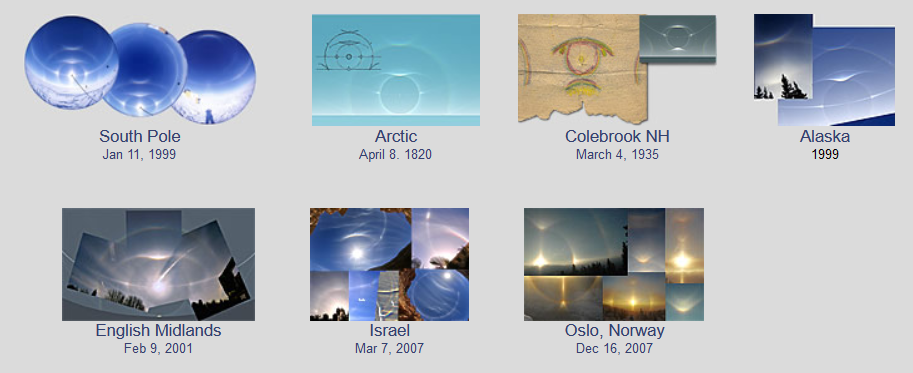Multiple Halo Displays
Multiple Halo Displays: A Spectacular Sight to Behold
When it comes to atmospheric optics, few displays are as captivating as multiple halo displays. These remarkable events feature a variety of halos, ranging from the bright and sharp "everyday" ones to the fainter and rarer arcs that criss-cross the sky. Observing multiple halo displays is a chance to witness these natural phenomena in their full magnificence, providing an opportunity to search for the rarest halos and perhaps even discover new ones.
Understanding Halos: A Brief Overview
Halos are optical phenomena that occur when light interacts with ice crystals suspended in the atmosphere. These crystals act as tiny prisms, bending and refracting light to create stunning visual effects. The most common type of halo is the 22-degree halo, which forms a circular ring around the sun or moon. This halo is caused by the refraction and reflection of light within hexagonal ice crystals.
The Beauty of Multiple Halo Displays
Multiple halo displays offer a captivating spectacle that goes beyond the familiar 22-degree halo. While the primary halo steals the show with its bright and sharp appearance, it is often accompanied by an array of secondary halos and arcs. These additional halos can take various forms, such as the rare 46-degree halo or the even rarer circumzenithal arc, which appears as an upside-down rainbow near the zenith.
Exploring the Rare and Uncommon Halos
One of the most exciting aspects of multiple halo displays is the opportunity to observe and identify rare halos. These elusive phenomena are not commonly seen in the sky, making their appearance all the more special. Some of the rare halos that may be observed during multiple halo displays include:
- The Parry arc: A curved band of light located below the sun or moon.
- The Lowitz arc: A pair of arcs that intersect near the 22-degree halo, forming a distinctive "X" shape.
- The Wegener arc: A faint arc that extends outward from the 22-degree halo, resembling a tail.
Discovering New Halos: The Joy of Exploration
Multiple halo displays not only allow us to appreciate the beauty of known halos but also provide an opportunity for discovery. As observers, we have the chance to carefully study the sky and potentially identify new halos or variations of existing ones. By documenting and sharing our observations, we contribute to the ever-growing body of knowledge in atmospheric optics, enriching our understanding of these mesmerizing phenomena.
Tips for Observing Multiple Halo Displays
To make the most of multiple halo displays, consider the following tips:
- Choose a location with an unobstructed view of the sky to maximize your chances of observing a wide range of halos.
- Pay attention to weather conditions, as certain atmospheric conditions are more conducive to halo formation.
- Use polarized sunglasses or a polarizing filter on your camera lens to enhance the visibility of halos.
- Be patient and observant, as multiple halo displays may evolve and change over time.
The Delight of Citizen Science
Multiple halo displays provide an excellent opportunity for citizen scientists to contribute to scientific knowledge. By reporting your observations to organizations or online platforms dedicated to atmospheric optics, you can help researchers gain valuable insights into these fascinating phenomena. Your observations may even lead to new discoveries or shed light on the behavior of rare halos.
Conclusion: Embrace the Wonder of Multiple Halo Displays
In conclusion, multiple halo displays offer a captivating experience for sky enthusiasts and scientists alike. These displays showcase a variety of halos, ranging from the common to the rare and elusive. By immersing ourselves in the study of these atmospheric phenomena, we can deepen our appreciation for the wonders of the natural world and contribute to our collective understanding of the intricate workings of light and ice in the sky. So, the next time you find yourself gazing at the heavens, keep an eye out for multiple halo displays and let their magnificence inspire awe and curiosity.
The best multiple halo displays have exceptionally bright and sharp 'everyday' halos. The sky is also criss-crossed by fainter and rarer arcs.
These displays are a chance to savour halos in their full magnificence, to search for the rarest and to perhaps discover new ones.

Note: this article has been automatically converted from the old site and may not appear as intended. You can find the original article here.
Reference Atmospheric Optics
If you use any of the definitions, information, or data presented on Atmospheric Optics, please copy the link or reference below to properly credit us as the reference source. Thank you!
-
<a href="https://atoptics.co.uk/blog/multiple-halo-displays/">Multiple Halo Displays</a>
-
"Multiple Halo Displays". Atmospheric Optics. Accessed on November 26, 2024. https://atoptics.co.uk/blog/multiple-halo-displays/.
-
"Multiple Halo Displays". Atmospheric Optics, https://atoptics.co.uk/blog/multiple-halo-displays/. Accessed 26 November, 2024
-
Multiple Halo Displays. Atmospheric Optics. Retrieved from https://atoptics.co.uk/blog/multiple-halo-displays/.